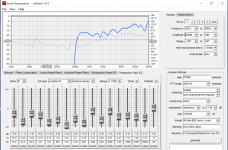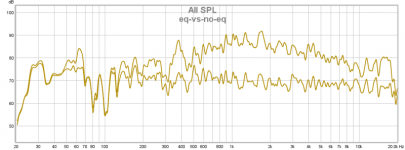What convolution engine are you using?
What do your EQs look like? (maybe show us a rephase graph screenshot, with any measurement bypassed)
At what SPL and dBFS level are you recording these measurements?
Thank you for the input, Thomas.
I'm using Equalizer APO. It uses FFTW3 for convolution. I doubt that's the case since the convolution causes no distortion if there are only high- or low-pass filters. The first chart included a 3-way crossover generated with rephase yet the distortion level was lower.
I'm attaching a screenshot with EQ settings for the tweeter.
Amplifier's volume setting was the same. Actual volume was lower due to the equalization applied. I'm attaching a volume comparison chart as well.
Attachments
You might just be seeing an increase in relative noise ratio then.Amplifier's volume setting was the same. Actual volume was lower due to the equalization applied. I'm attaching a volume comparison chart as well.
You might just be seeing an increase in relative noise ratio then.
Thank you for the suggestions. This indeed improved THD values.
About the distortion measurements of chebum, they were the farfield measurement of loudspeaker's output. We saw only distortion curves with percentage, not dB.
Typical domestic ambient noise level is 30-35dB. Typical hifi-loudspeaker must play at 95dB/1m or louder to show "real" distortion above noise level. One standard is to measure/set spl to 95dB at 1000Hz with some smoothing of response. Another way is to use standard voltage, but then we must also see the measured dB values to compare.
In theory, loudspeaker equalization always leads to higher distortion levels (when we look at spectrum). There is no way to raise efficiency or lower distortion by eq. When input voltage is lowered, distortion gets lower too. With eq we typically suppress loud parts of spectrum which leads to effectively lower total efficiency. Then, to get same spl level in a measurement (say that 95dB/1m), we must use higher voltage and we will see higher distortion percentage.
If quiet parts of response are amplified, distortion rises just as well and for same standard spl, we get higher distortion again. The problem with this is that we might introduce clipping in loud parts of music signal, in digital domain. It is very common to see music playing very close to clipping of even badly clipping because of "the loudness war" in original signal, so there is not room for eq left. The propability of this depends on where in signal chain spl volume control and eq is performed.
Typical domestic ambient noise level is 30-35dB. Typical hifi-loudspeaker must play at 95dB/1m or louder to show "real" distortion above noise level. One standard is to measure/set spl to 95dB at 1000Hz with some smoothing of response. Another way is to use standard voltage, but then we must also see the measured dB values to compare.
In theory, loudspeaker equalization always leads to higher distortion levels (when we look at spectrum). There is no way to raise efficiency or lower distortion by eq. When input voltage is lowered, distortion gets lower too. With eq we typically suppress loud parts of spectrum which leads to effectively lower total efficiency. Then, to get same spl level in a measurement (say that 95dB/1m), we must use higher voltage and we will see higher distortion percentage.
If quiet parts of response are amplified, distortion rises just as well and for same standard spl, we get higher distortion again. The problem with this is that we might introduce clipping in loud parts of music signal, in digital domain. It is very common to see music playing very close to clipping of even badly clipping because of "the loudness war" in original signal, so there is not room for eq left. The propability of this depends on where in signal chain spl volume control and eq is performed.
Last edited:
soon enoughpos, when do you plan to release the bugs implemented last week on high altitude in the alps?
I will look into that and implement it in the next release if it proves usefulA question (for fun/learning).
What about the :
Dolph–Chebyshev window (rePhase or REW) ?
Any trade-off ?
Hello,
I noticed something when tested my DE250 on RCF H100 horn. Did a FIR and then an IIR high pass @ 1200Hz. The phase for the IIR filter is corrected with some 'compensate' 2nd order all-pass.
So the measurement looks the same but I can clearly say that the sound is more detailed/refined with the IIR filter. It has a better definition, 'bite'. I listen at low level, 70 to 85dB at listening position.
What is the cause? the pre-ringing of the FIR filter?
Thanks!
I noticed something when tested my DE250 on RCF H100 horn. Did a FIR and then an IIR high pass @ 1200Hz. The phase for the IIR filter is corrected with some 'compensate' 2nd order all-pass.
So the measurement looks the same but I can clearly say that the sound is more detailed/refined with the IIR filter. It has a better definition, 'bite'. I listen at low level, 70 to 85dB at listening position.
What is the cause? the pre-ringing of the FIR filter?
Thanks!
Hello arcgotic,
Just to make sure I understand properly, you are comparing IIR+FIR linearization to full FIR, right?
In both cases you are also supposed to no just linearize the phase of the electrical filter, but of the resulting acoustical filter (ie electrical+"mechanical", both magnitude and phase).
Anyway, IIR+FIR linearization or full FIR, the result should be the same down to the quantization errors, including the amount of pre/post ringing.
Do the measured impulse responses also look the same?
Just to make sure I understand properly, you are comparing IIR+FIR linearization to full FIR, right?
In both cases you are also supposed to no just linearize the phase of the electrical filter, but of the resulting acoustical filter (ie electrical+"mechanical", both magnitude and phase).
Anyway, IIR+FIR linearization or full FIR, the result should be the same down to the quantization errors, including the amount of pre/post ringing.
Do the measured impulse responses also look the same?
So the measurement looks the same but I can clearly say that the sound is more detailed/refined with the IIR filter. It has a better definition, 'bite'. I listen at low level, 70 to 85dB at listening position.
What is the cause? the pre-ringing of the FIR filter?
Thanks!
How many taps does your fir filter have? In my experience shorter filters sound rough. Longer filters (300ms and longer) sound much smoother. I didn't see any ringing in REW measurements, but still shorter FIRs sound more rough to my ears.
Don't know the reasons except that shorter FIRs doesn't follow target curve as precise as with longer FIRs. Probably, these smallish errors make shorter FIR filters sound rough.
Personally, I hear a lot of sound degradation if I use any digital filter DSP or any software to EQ or change phase. THD must increase, measurable or not.
I hear more distortion on vinyl but the sound is so much better in many aspects that I never listen to digital, cd, hi-rez digital recordings are no longer listened too.
The sound wave is a whole, dissecting it into bits and parts and trying to arrange phase/eq/filter bands, however advanced the maths is something impossible.
In comparison, for vinyl you use only 2 passive filters to restore the curve, then a very clever XO for the speakers (best time, impulse, EQ, phase, resonance damping, polar response possible), if it is done right you don't need EQ after, this is the whole theory of high fidelity sound. The best recordings were done with this philosophy. Only EQ before the song is recorded, 2 or 3 takes without any EQ post recording.
I hear more distortion on vinyl but the sound is so much better in many aspects that I never listen to digital, cd, hi-rez digital recordings are no longer listened too.
The sound wave is a whole, dissecting it into bits and parts and trying to arrange phase/eq/filter bands, however advanced the maths is something impossible.
In comparison, for vinyl you use only 2 passive filters to restore the curve, then a very clever XO for the speakers (best time, impulse, EQ, phase, resonance damping, polar response possible), if it is done right you don't need EQ after, this is the whole theory of high fidelity sound. The best recordings were done with this philosophy. Only EQ before the song is recorded, 2 or 3 takes without any EQ post recording.
Last edited:
With eq we typically suppress loud parts of spectrum which leads to effectively lower total efficiency. Then, to get same spl level in a measurement (say that 95dB/1m), we must use higher voltage and we will see higher distortion percentage.
I'm not sure we will see higher voltages across the whole spectrum. The voltage will be higher for initially quite parts of the spectrum and lower for the louder frequencies. It isn't that we will need more Watts to get the same loudness level with an equalized speaker. We won't. Just the Watts will be spread differently. Some frequencies will see higher voltages than others.
I use 4000 taps filters. I will make measurements soon.
One filter uses only minimum phase filters and minimm-phase PEQ, and the other one linear phase filters and linear PEQ.
These are too short even if your stream is at 44.1KHz. Try 16000 taps, it will sound smoother. Also, check if you enabled optimizations in rephase.
If your convolver supports different formats, choose 32bit WAV, not 16bit. 32bit filter will have higher precision.
I would suggest using linear phase filters and minimum phase EQ. As drivers are minimum phase devices the (p)EQ will fix the phase as well, when the PEQ fixes the frequency response. The linear phase filters are ment to compensate for crossovers. Generally speaking, any response EQ would/could be minimum phase for restoring frequency and phase together.I use 4000 taps filters. I will make measurements soon.
One filter uses only minimum phase filters and minimm-phase PEQ, and the other one linear phase filters and linear PEQ.
I use 4000 taps filters. I will make measurements soon.
One filter uses only minimum phase filters and minimm-phase PEQ, and the other one linear phase filters and linear PEQ.
That is quite different from what I understood from your last post!
Also, check if you enabled optimizations in rephase.
I would recommend not to use optimization, unless you really need it (ie you don't have enough taps at hand for the task).
Optimization is an iterative process that tries to get the result magnitude response as close as possible to the target one, which often implies loosening the magnitude/phase relation...
- Home
- Design & Build
- Software Tools
- rePhase, a loudspeaker phase linearization, EQ and FIR filtering tool


